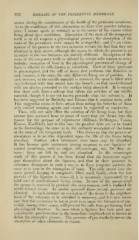Page 912 - My FlipBook
P. 912
922 DISEASES OF THE PERIDENTAL MEMBRANE.
occurs during the maintenance of the health of the peridental membrane.
As to the conditions of this absorption Ave have very positive informa-
tion ; I cannot speak so certainly as to the nature of the causes which
bring about these conditions. Absorption of the roots of the temporary
teeth is in all respects a physiological process ; the absorption of the
roots of the permanent teeth cannot be so regarded ; and yet an exam-
ination of the process in the two instances reveals the fact that they are
identical in their nature, although the causes by which the process is set
in action in the two instances are entirely different. Resorption of the
roots of the temporary teeth is effected by certain cells known as odon-
toclast ; resorption of bone in the physiological processes of change of
form is effected by cells known as osteoclasts. Each of these processes
is physiological, and the cell or tissue that performs this function in
each instance, is the same, the only difference being one of position. In
each instance, as the calcific material is removed, the space is filled with
ne\\ly-fbrmed cells that crowd into the breach ; so that newly-formed
cells are always presented to the surface being absorbed. It is certain
that these cells form a solvent that effects the solution of the calcific
material, though it is not yet known precisely what this solvent is. It
has been suggested by Rustizky and Krause that it contains lactic acid.
This suo;";estion seems to have arisen from noting the behavior of these
cells toward stainino; agrents, and cannot be reo;arded as conclusive.
These cells not only effect the solution of the living bone, but they
burrow into necrosed bone or pieces of ivory that are thrust into the
tissues for the purpose of experiment (Billroth, DelNIorgan, Tomes,
Krause, Koelliker), and in this case the peculiar cells are to be found
in the burrowings, the same as in the ordinary resorption of the bones
or the roots of the temporary teeth. This shows us that the process of
absorption is in no wise dependent upon the life of the tissue being
absorbed. Further, other substances than bone may be absorbed.
It has become quite customary among surgeons to use ligatures of
animal membrane, such as catgut, silkworm-gut, etc., for deep su-
tures ; these are left in, and are absorbed. In the microscopic
study of this process it has been found that the leucocytes aggre-
gate themselves about the ligature, and that in their presence its
substance disappears in such a way as to foi'ui irregular pockets, the
same as is seen in the absorption of bone. The cells crowd into the
S])ace gained, keeping it completely filled, until, finally, when the last
particle of the ligature is removed, it is accurately represented by a
solid cord of newly-formed living tissue. In case of the sponge-c/raft
the sponge is removed in precisely the same manner, and is replaced by
newly-formed tissue. In modus operandi these several processes are
identical. In each instance an excitation of the tissue in the neighboi'-
hood of the substance to be absorbed is necessary, and it is also neces-
sary that this excitation be not so great as to cause the formation of pus,
as this, among other causes, w^ill prevent the cells from performing their
pliysiological function. In cases where a ligature has been used any
considerable pus-formation in the immediate neighborhood is known to
defeat the absorptive process. The presence of pus similarly arrests the
absorption of other substances or tissues.


